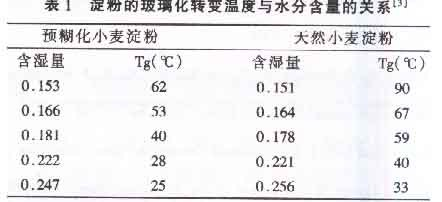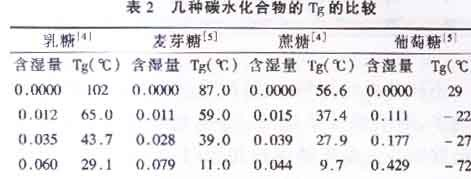Brief Discussion on the Relationship between Glass Transition Temperature and Food Composition
Overview
Glass transition temperature is a very important physicochemical parameter that determines the quality, safety and stability of a food system. In the theory of food polymer science, there are two definitions of the glass transition temperature according to the moisture content of food materials: for low moisture foods (LWF, the mass fraction of water is less than 20%), the glass transition temperature is generally greater than 0 °C. It is called Tg; for high-moisture or medium-moisture foods (HMFIMF, the mass fraction of water is more than 20%), except for very small samples, the cooling rate cannot be reached very high, so it is generally impossible to achieve complete vitrification. At this time, the glass transition temperature refers to the temperature at which the maximum freeze-concentrated solution undergoes glass transition is defined as Tg. In polymer science, the state in which the matrix is ​​lower than the glass transition temperature is generally referred to as the glass state. The state in which the substrate is above the glass transition temperature is referred to as the rubbery state. Glass transition refers to the transformation of the matrix from a rubbery state to a glassy state. In the glass state, due to the higher viscosity of the system and the smaller free volume, some diffusion-controlled reaction rates are very slow or not occur; while in the rubber state, the viscosity of the system is significantly reduced, but the free volume is significantly increased. The response rate of the ambassador controlled by diffusion is also rapidly increasing. Therefore, the glass state is very important for the safety and stability of food processing and storage.
1 Relationship between glass transition temperature and food composition
Significant changes in the series of physical and mechanical properties in the system before and after Tg have a great impact on the processing and quality of most solid foods. Too low Tg may also limit the processing of foods to produce a variety of undesirable results. . Paying attention to Tg and analyzing its influencing factors can help people better understand food processing and storage characteristics and improve product quality. Food ingredients are very complex The various ingredients in the food have an effect on the glass transition temperature of the food. The main solid ingredients in food are protein, carbohydrates and fat. Carbohydrates have a great influence on amorphous dry foods. Common sugars have low Tg in sugar and glucose, so they significantly reduce Tg in high-sugar foods. Generally, the effect of protein and fat on Tg is not significant. . 1.1 Moisture content The moisture in the food has a special effect on the food. The water has a very low Tg of -135 ° C and moisture can be considered as a strong plasticizer. On the one hand, the molecular weight of water is much smaller than the molecular weight of other components in foods such as glycoproteins and fats, and the activity is relatively easy, and it is convenient to provide the space required for the activity of the molecular segment to reduce the system; When the components are compatible with water, the water can interact with the polar genes on the molecules of other components, reducing the hydrogen chain action inside and outside the molecule, reducing the rigidity and enhancing the flexibility, and exhibiting a decrease in Tg. Therefore, understanding the relationship between moisture content and Tg is of great significance. The moisture content is the main factor affecting the glass transition temperature of the food system without the influence of other external factors. Due to the plasticization effect of moisture on amorphous materials, the glass transition temperature is greatly affected by the moisture content of the product, especially for dry foods with relatively low moisture content. The physical properties and texture of the processed food are affected by water plasticization. More remarkable. When the starch sucrose mixture is anhydrous, the Tg is 60 ° C; when the moisture rises to 2%, the Tg is lowered to 20 t; when the moisture is raised to 6%, the Tg is only 10 ° C. In general, for every 1% increase in water, the Tg is reduced by 5 ° C - 10 ° C

Table 1 shows the relationship between starch moisture content and Tg of wheat starch and pre-gelatinized wheat. It can be seen from Table 1 that although the pre-gelatinization has a certain influence on the Tg of the starch, the children of both starches decrease as the moisture content increases.
1.2 Carbon-hydrated carbohydrates are one of the main ingredients in foods. The Tg of various carbohydrates, especially soluble small-molecule carbohydrates, have significant effects on the processing and quality of dry products such as sugar, glucose and sucrose. Moreover, the bioprotective effects of carbohydrates are also related to their ability to form glass. The order in which the saccharides are effective in biochemical protection is consistent with the order in which their glass transition temperatures are high to low. The table gives the glass transition temperatures for several carbohydrates at different moisture contents. It can be seen from Table 2 that the order of glass transition temperature of these saccharides from high to low in the case of similar moisture content is: lactose > maltose > sucrose > glucose. In the process of food processing, in order to ensure the quality of the food and the stability of storage, the selection of appropriate Tg carbohydrates has certain guiding significance.

Tv Mount,Wall Mount Screens,Adjustable Mobile Stand,Tiled Screens Wall Mount
Dongguan Aoxing Audio Visual Equipment CO.,Ltd , https://www.aoxing-whiteboard.com